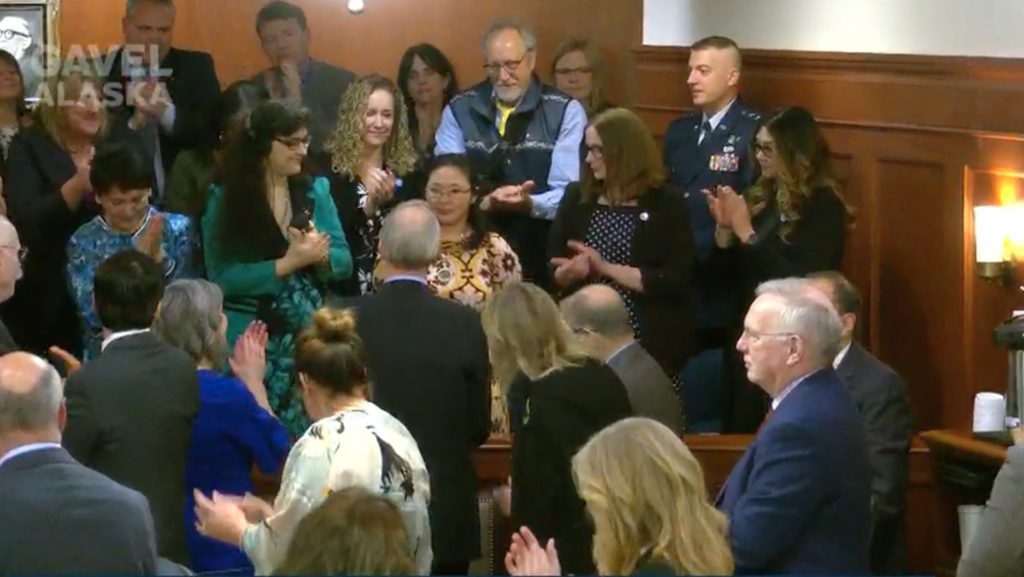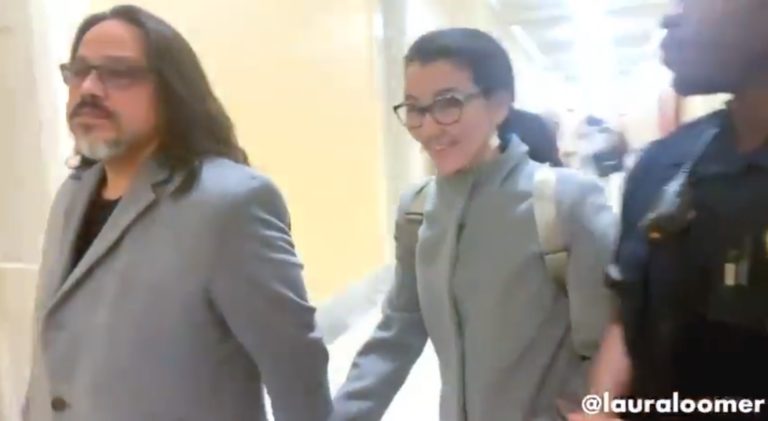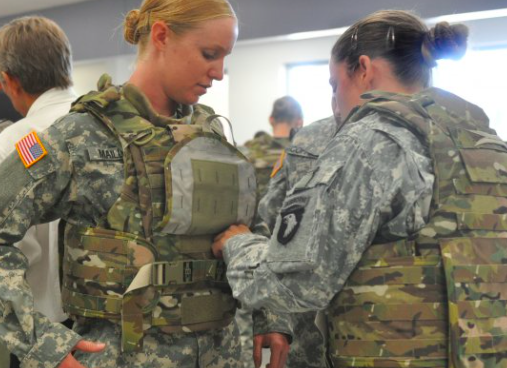Gov. Mike Dunleavy’s fifth State of the State Address in Juneau on Jan. 23 touched on many of the major topics he will focus on this year. Among other initiatives, he made the case for spending more to defend Alaska’s statehood development rights against the attempts by the federal government to lock the state down. He spoke to his initiative to protect Alaskans from sexual assault, and he said he would attempt, through legislation, to crack down on fentanyl traffickers.
Dunleavy did not speak much about oil and gas development, which is Alaska’s major economic driver, but did speak about expanding into carbon sequestration, strengthening the State Defense Force to be ready to respond to disasters, and increasing efforts to strengthen food security, including fisheries sustainability.
And he went off the speech officially released to the media talk about how he is a pro-life governor: There’s no tomorrow without people, he said. We have to make it ok to have families, to have children.” He spoke to the need to have policies that make Alaska a place where families want to live.
The state’s policies should not be a disincentive to having children, he said. Check back with Must Read Alaska for analysis of this State of the State.
His text follows, with the exception of the strong pro-life, pro-family message he included at the end:
Thank you, Lieutenant Governor Dahlstrom, Senate President Stevens, Speaker Tilton, and members of the 33rd Legislative Session.
I want to thank you for the invitation to speak to our fellow Alaskans tonight. First, I want to recognize my wife of 35 years, First Lady Rose Dunleavy.
It would be virtually impossible to do this job without your support, and so, thank you, Rose, for putting up with me.
I’d also like to recognize the members of my cabinet in attendance tonight. Could you please stand and be recognized?
Thank you for everything you’re doing for the great State of Alaska.
To the members of the Legislature: Welcome, and thank you for wanting to serve your constituents.
Tonight, as I stand before you and the great people of Alaska regarding the state of our state, there is much to be thankful for.
I’m also optimistic about the start of this session because I believe what we do now … in the next four months, will set Alaska’s course not just for the next four years, but for the next 50 years and beyond.
We have a chance in this session to change the course of Alaska’s history.
But we won’t change history by accepting things the way they are, or the way they’ve always been.
As an example of this, I want to introduce you to an Alaskan who understands this, and who actually lives by it.
Heidi Lieb-Williams is the Chair of the Governor’s Council for Disabilities and Special Education, and she’s a champion at the state and federal level for our fellow Alaskans who are facing physical or mental challenges.
Her work has changed policy. It’s changed attitudes and it’s changed laws like the minimum wage exemption that allowed employers to pay smaller wages to Alaskans like Heidi.
Her tireless efforts helped us repeal that exemption in a bill last year, and I was proud to sign that bill with her at my side.
Heidi is a parent, she’s an advocate, she’s an entrepreneur, she’s an author, she’s an artist, she’s an inspiration to me, and to all of us.
Heidi, could you please stand and be recognized for your public service to the great State of Alaska?
Thank you, Heidi, for working so hard to change Alaska for the better.
Alaskans are a people that show their poise under pressure.
Over the past four years, we’ve overcome a historic earthquake, wildfires, landslides, and yes, a once-in-a-century pandemic. Nearly everything has been thrown at us but locusts.
Just this past September, hundreds of miles of our Western coasts and dozens of our communities were inundated with a powerful storm surge that upended homes, roads, boats, vehicles, and fish camps.
Thankfully, we didn’t suffer any loss of life in that storm.
Rather, we saw our communities come together to offer shelter, meals, and helping hands.
With winter fast approaching, local, state, and federal agencies joined with volunteer groups, the private sector, and nonprofit organizations for a massive recovery effort that was a race against time.
Together, homes were reset and repaired, and roads and seawalls were rebuilt.
As I traveled the region to monitor the recovery efforts, I met people who embody the toughness, the tenacity, and the leadership that became familiar to me when I lived and worked in rural Alaska.
One of our stops was in the town of Stebbins after the weather cleared enough for us to land.
We’d heard the town’s seawall had been damaged, and I wanted to see what kind of assistance we could provide.
Upon landing, I met Daisy Lockwood Katcheak, who is the city administrator of Stebbins.
Daisy didn’t have much time for standing around, and she was giving orders like a sergeant in the Marine Corps almost as soon as we got off the plane. I was impressed.
“Governor,” she said, “we gotta go. We’ve got lots to see.”
I quickly learned that Daisy was ahead of the game. She already had a damage assessment completed, and she already had a contractor and the rock lined up to rebuild the seawall.
By the end of our trip, I knew that Stebbins was going to be in great shape, because of her focus, diligence, and hard work.
By the end of our visit, I also told my team that I felt like I should be taking orders from her.
It was an honor to present Daisy with the Shirley Demientiff Award at the annual AFN convention, and I’m so glad to see her here again tonight representing all the community members who rose to the occasion under such difficult circumstances.
Daisy, would you please stand and be recognized?
Thank you, Daisy, for answering the call to serve your people, and Alaska.
How we answer that call to serve is a question for all of us.
I’m optimistic about the next four years – and the next 50 – because of everything we’ve achieved in the last four years to reach this moment in time, despite everything we’ve faced, such as:
- – Natural disasters
- – A $1.6 billion deficit, debts, and credit downgrades
- – A record-breaking crime wave
- – Negative $3 oil
- – A pandemic
- – Inflation at a 40-year highIn spite of all that, we’re still here, we’re still standing, and we’re moving forward.In the midst of it all, we delivered the biggest PFD in history last fall at a time when Alaskans needed it the most.Our credit outlook is improved, and our debts and liabilities are down.
Over the past four years, most of our agency operating spending is also down.My proposed budget for operating spending next year is nearly 4 percent lower than the one I inherited in 2019.
In my second year, the pandemic descended on Alaska, and it was supposed to wipe us out.
Like other places, we have lost friends, relatives, and loved ones, but as I stand here today, Alaska is fortunate in having the second-fewest deaths, and the fourth-lowest death rate per capita in the country.
While this is not something to celebrate, it’s something to keep in perspective.
We had the best survival rate in the country and at the same time we kept our industries running.
We respected local control and individual freedom.
We fought back and won against vaccine mandates and federal overreach.
While battling the pandemic and the asscoiated chaos, we kept the state moving forward.
We’ve also worked with the University to fund the world-class research that it does best: unmanned aircraft, heavy and viscous oil, critical minerals, hydrogen, micronuclear power, and mariculture.
We stabilized the ferry system with forward funding and are making it sustainable with a dedicated fund that’s not subject to the annual sweep.
With the help of the Legislature, we’ve increased funding for maintenance, we’ve upgraded the Hubbard to serve longer routes on the Panhandle and will do the same for the Tazlina in the upcoming year. We’re also replacing the old “Rusty Tusty,” the Tustumena.
And, our largest ferry, the Columbia, will be back serving Alaska beginning in February.
Thanks to bipartisan support from 41 legislators, another accomplishment that gives me great optimism for our future was the passage of the Alaska READS Act last session.
For the first time, we have an education policy that demands accountability, that sets benchmarks, that provides the tools our school districts and our teachers need to set our students on a course for success in life.
No longer will we measure achievements in education simply by how much we’re spending. We’ll measure achievements by how well our kids are performing.
Thanks again to bipartisan support, we’ve put record amounts of resources into Public Safety, and we’ve grown our ranks of State Troopers and Village Public Safety Officers.
When I took office, we had just 45 working VPSOs compared to nearly 100 in 2014. With increased funding and by working with our local partners to recruit and retain officers, we’re now up to 68 at the end of 2022.
We all know that being a public safety officer is a difficult job. But we’re grateful for the individuals who step up to do it for us.
One of those hard-working individuals is here tonight.
Sergeant Carlos “Julian” Navarro was hired by Kawerak Incorporated in 2009 to serve the community of Golovin as a VPSO.
For the past 13 years, Sergeant Navarro has served his community with a calm and quiet presence as he’s taken on bootleggers and drug traffickers, and worked with our State Troopers to hold offenders accountable.
Back in 2015, he also saved the life of a four-month-old child in distress by performing CPR for over two hours while waiting for a medevac flight to arrive from Anchorage.
His actions helped protect lives once again this past fall, as the remains of Typhoon Merbok approached the coast. He ensured the community was prepared and elders were sheltered.
He helped keep the power on and worked around the clock before and after the storm to meet everyone’s needs for food and water.
Sergeant Navarro represents the very best of the VPSO program, and the many roles they serve when called upon.
On behalf of Alaska, thank you, Sergeant Navarro, for all you’re doing to serve your community.
Will you please stand and be recognized for your hard work, and the work of your fellow officers?
Thank you, again, Sergeant, for everything you do.
Our investments in protecting Alaskans have absolutely shown results. Alaska is safer today than it was four years ago.
Thanks to the work of our men and women in law enforcement, and the resources and the policies we’ve put in place, our crime rate in 2021 declined to a 41-year low, just four years after it reached a 19-year high in 2017.
This is unprecedented. And I have to thank the members of the Legislature past and present for their help with this, along with all of our law enforcement personnel and prosecutors.
This is why policy matters.
Over the past five years, we’ve cleared the historic sexual assault kit backlog and are currently collecting owed DNA, and this evidence has resulted in indictments as we pursue justice for victims.
We’ve also put policies in place to make sure these backlogs never happen again.
To be clear, we’re all well aware that there is more to do to protect all Alaskans no matter who they are or where they live.
We did take a major step to protect Alaskans last year when we reformed our outdated consent law.
Prior to this bill’s passage, as hard as it is to believe, in the state of Alaska under Alaska law, the onus was on the victim to physically resist the perpetrator.
As we know, when such crimes are being committed, physically resisting isn’t always possible.
And, as all of us know, no should mean no.
Now, it does. Now, we have the tools to prosecute these perpetrators.
Now, for the first time in Alaska history, no actually means no.
We celebrate this commonsense reform, but it took until the last day of the last session to get it done.
It took legislators who put the people over partisanship.
For that, I want to thank Senators such as Shelley Hughes and Jesse Kiehl, and former Representatives Geran Tarr and Sara Rasmussen in particular for getting this reform to my desk.
They refused to accept the possibility that this bill would end up as just another casualty of the clock running out in Juneau.
Legislators end up casting the votes, but there’s someone else I want to introduce you to who played an important part in getting this bill over the finish line.
Like Heidi before, she’s a champion for her cause. She refuses to accept things the way they are, or how they’ve always been.

Katie Botz is here tonight, and I want to personally thank her on behalf of all Alaskans, and every survivor that may feel like they don’t have a voice, or worse, that they’re not being heard.
In spite of the pain it brought her, Katie raised her voice.
Katie believed that speaking up would help keep others from experiencing what she’s gone through, and that speaking up would ensure that justice would be served on those who victimize others.
In the end, we almost let her down when the passage of that bill was in jeopardy.
Thankfully, we didn’t, and I want to read you something she wrote in letters to newspapers after the bill passed:
“I’m feeling more positive now and I believe that one person can actually help make a difference after all.”
Katie, I’m here to let you know that you did make a difference. You demonstrated that one person can make a difference.
Thank you for not giving up.
Thank you for reminding us why we’re here.
We’re here to help the people of Alaska.
Katie, could you please stand and be recognized for all your efforts to make a difference for the better?
Thank you, again, Katie, for your courage and your dedication.
Several years ago, I ran for this office on issues that included reforming public safety and education, but the very first crisis my administration had to tackle was at the Alaska Psychiatric Institute.
Capacity had shrunk to just 19 beds. The Chilkat adolescent unit had stopped taking admissions for youths in acute crisis.
The facility was in danger of losing its ability to accept federal funds.
We didn’t run from this challenge. We rose to meet it.
As a result, the bed capacity has increased from 19 to 71 under my administration. The adolescent unit reopened in May 2021 and is fully utilized today.
Thanks to countless dedicated individuals in my administration and at API, we righted the ship.
It was thanks to people on the front lines like Rebecca Morrissey.
Following in her father’s footsteps, she’s a second-generation psychiatric nurse at API.
Since 2016, she’s worked in the adult psychiatric unit and most recently in hospital education.
She’s seen the darkest days at API, and she’s also seen the incredible turnaround in the past four years.
Through her dedicated work and the work of so many others, now API is providing the services Alaskans expect us to deliver.
Rebecca, please stand and be recognized on behalf of your work, and the work of your colleagues at API.
Thank you, again, Rebecca, for serving Alaska.
The turnaround at API is an example of what’s possible when we focus on making government work. It proves we can fix broken systems rather than just accept the status quo.
This is why I’m optimistic. This is why I beleive we can get things done this year.
To fulfill our destiny as a state, one challenge we must overcome is the way we’re perceived by some Outside interests.
In many respects we’ve been stereotyped as a land of fish and igloos, frigid temperatures, and fat bears.
We’re a place everyone wants to visit and a good place to shoot a reality show, and that’s fine.
However, when it comes to policies impacting Alaska, all too often these perceptions, misconceptions, and stereotypes can do real harm to Alaska and our future.
Sixty-four years after we’ve joined the union, Alaska is still fighting for its rights to be treated as a sovereign by the federal government that’s on equal footing with the other states.
For example, the Biden Administration, through executive orders over the past two years, has restricted Alaska’s ability to capitalize on the resources within our borders.
No less than 41 executive actions – 41 – have been taken by the current administration to strangle Alaska’s promises of statehood.
Few other states have this challenge. For example, I’ve never heard an Alaskan worry about what they’re doing in Arkansas, or Rhode Island, or Delaware.
But there is a constant stream of people from outside of here, trying to turn Alaska into their fairy tale image of a national park where income can be produced merely on love and goodwill.
This isn’t reality, but this is a challenge we struggle with every day, and I’ll do everything in my power to defend the rights guaranteed to Alaskans at Statehood.
As Governor, and as legislators, we have a moral obligation to ensure that we fulfill the promise of statehood and are allowed to create our own destiny for future generations.
When federal agencies are clearly wrong, when they’re misinterpreting the Statehood Act, ANILCA, or other laws governing our relationship with the federal government, we have an obligation to stop them.
When environmental extremists, NIMBYists, and Luddites are wrong, they must be opposed as well.
We have a right to exist on equal footing with the rest of the 49 states. That’s a fact. We’re no longer a territory. We’re no longer a district. We’re the 49th state.
We won’t accept that we’re second rate, that we’re just a piece of the park system … that we’re just a billionaires’ playground to set up for glamping for a couple weeks and then take off for Davos in their private jets.
Those of us in this room have an obligation fight back against this elitist attitude, and to secure a future for our kids and grandkids.
For that reason, my Statehood Defense budget goes beyond additional funding for our legal efforts. It has to.
We need legal resources, but we also need to fund research to defend ourselves against these Outside actions that threaten to close down areas as large as Texas or California based upon flawed, contrived, or incomplete data and assumptions.
However, we can’t just play defense. We must also go on the offense as well.
For too long, we’ve allowed others to tell our story. The “North to Opportunity” initiative in my proposed budget is going to change that.
We know we’ve been the leaders in responsible resource development whether that’s mining, oil and gas, or fisheries.
We know we’ve been doing ESG since before ESG was the latest fashionable thing on Wall Street or in Washington.
We’ve never had a major mining accident here in Alaska.
We don’t flare our gas, and never have, and we don’t have to be told not to by the federal government.
We have stricter spill response rules than the federal government itself.
We’re going to tell this story, our story, the real story, and it’s not the story the extremists want everyone to believe.
Through multiple media channels and targeted industry outreach, we’ll promote our unmatched opportunities for investment and development.
From logistics to unmanned aircraft, from critical minerals to low and no carbon energy, and much more, Alaska is a resource powerhouse in a strategic position on the globe that has much more to offer than just our beautiful scenery and wildlife.
Now is the time to share our story – not their fairy tales – with the rest of the world, and I’m urging members of the Legislature to support this initiative.
I’m also calling on members of the Legislature to support the bills under my People First Initiative.
My administration filed several bills last year with commonsense measures to increase protections for survivors of sexual assault and domestic violence, to increase penalties for offenders, and to take on sex trafficking.
One of these bills expanded the definition of sex trafficking to include those predators who are coercing the most vulnerable into the sex trades with threats such as withholding basic needs like food, clothing, or shelter.
As incredible as it sounds, this is happening today, right here in Alaska, right now, in 2023.
Unfortunately, the bills we filed last year were left on the table, in some cases without receiving even a single hearing.
We’ll file these bills again because this issue is too important to wait another year.
And I’m calling on legislators to give survivors and their advocates the opportunity to testify and shape these bills, and send them to my desk for a signature. They deserve nothing less.
Protecting public safety, protecting our most vulnerable, is the most important job for any elected official.
Bringing an end to the scourge of sexual assault and domestic violence is a moral imperative, but, unfortunately, the issue of fentanyl is also a pressing issue we must address.
As I announced in October, I’ll be introducing legislation that declares war on those who are recklessly dealing fentanyl and fentanyl-laced drugs in our communities.
This drug is not your grandparents’ marijuana. This drug, taken in the smallest amounts, knowingly or unknowingly, can cause death in a matter of moments.
Last year, law enforcement seized 13.4 million potentially fatal doses of fentanyl here in Alaska.
That’s enough to kill the entire population of Alaska 18 times over, and I’m thankful to our local, state, and federal drug enforcement officers who no doubt saved countless Alaskan lives through these efforts.
Tragically, though, we have lost too many Alaskans to this deadly poison that has killed hundreds of thousands of Americans in the past few years.
The morally-bankrupt who are peddling drugs know that death is a possibility, and they don’t give a rip.
So we’re putting them on notice tonight.
I’ll introduce legislation to increase the penalty for a dealer who sells poison that results in the death of anyone.
Right now, under current law, this act can only be charged as manslaughter with a maximum sentence of just 20 years.
Under my legislation, we’ll increase this penalty to second-degree murder with a sentence of up to 99 years. These people deserve nothing less.
To those individuals who couldn’t care less about human life: You aren’t just gambling with the lives of others when you peddle this poison. You’re gambling with your own.
We’re going to lock you up and we’re going to throw away the key.
We’re not going to let you keep killing Alaskans and tearing families apart, and we’ll be relentless in the pursuit of justice.
As we focus on enforcement and intercepting this deadly fentanyl poison, we must also be focused on treatment as well.
If you’re struggling with addiction, we’ll work with you to help you find treatment.
Yes, this will cost money. But keep in mind, these people aren’t strangers. They’re our fellow Alaskans.
These are family members, friends, spouses, and coworkers that often times got addicted to opioids following accidents, injuries, or surgeries.
Through our Department of Health, and in conjunction with our schools and nonprofit partners, we’ll do everything possible to educate Alaskans so they don’t become addicted.
But if you do, we’ll continue our work to end the stigma around addiction so that people who are struggling will seek help, and get it.
These initiatives require resources, but we are better positioned to fund them today thanks to our work over the past four years.
We’ve paid off hundreds of millions in tax credit debts, and our pension obligations are reduced thanks to sound investments.
We’ve held agency spending in check, and we put some of last year’s windfall into savings.
So, while it’s true that we face a deficit at the moment, that deficit is far more manageable than the $1.6 billion gap I inherited.
Because of our improved fiscal situation, my proposed budget funds additional services and initiatives without increasing overall spending.
One area we’re proposing to add resources is the Healthy Families Initiative.
We are asking for funding to expand postpartum Medicaid coverage from 60 days to 12 months to ensure that moms and their children get off to a healthy start in life.
This initiative will also fund recruitment and retention of the health care professionals we need to fill the 5,000 jobs that will be required over the next 10 years.
The Healthy Families initiative will also add support to our efforts to battle tuberculosis. We have the highest rate in the country, at nearly three times the national average.
This problem dates back more than a century, and 70 percent of our TB cases afflict our Native populations.
With these increased resources, our goal is to eliminate TB as a health threat in Alaska once and for all.
Another area we’re adding resources is the Rural Professional Housing Program.
My proposed budget will expand eligibility to include agencies such as the Office of Children’s Services that are needed in our remote communities.
In keeping with our efforts to be prepared for anything, I’m also proposing to expand our State Defense Force, whose members proved to be a critical asset in our storm response and recovery last fall.
With more veterans per capita than any other state, we have a deep pool of individuals with a wide range of skills that we can draw from to build up its ranks.
A stronger State Defense Force won’t just be available for disaster response. Its members might also deploy to help run a power plant, or provide tech support, or operate heavy equipment, whatever the need may be.
A stronger State Defense Force will build a more secure and more independent Alaska, and I’m looking forward to working with legislators to support this proposal.
We’re also going to build on the work of the Bycatch Review Task Force and the Food Security and Independence Task Force.
We know that some of our most valuable fisheries are in trouble. Halibut, Western Alaska salmon, and Bering Sea crab are vital not only to our economy, but to Alaska’s way of life.
Fishing is the beating heart of Alaska.
It’s provided food and shaped the culture of Alaska for thousands of years.
It’s the largest source of private sector jobs in the state. It generates millions of dollars in revenue for our coastal communities.
Anyone familiar with fisheries management knows how complex it can be among users, gear types, target species, and regions.
Like the price of oil, Alaska has also experienced boom-and-bust periods in our fisheries.
At the same time, we don’t have to accept that we’re mere bystanders at the mercy of forces outside our control.
My budget puts additional resources into Western Alaska salmon research, and the Bycatch Task Force will provide my administration with additional management recommendations.
We must do all we can to sustain our great fisheries and ensure that our resources are managed to benefit Alaskans first and foremost.
These fisheries are also a major source of food security, and the Food Security Task Force is wrapping up its work now.
As I await its final report and recommendations, we’re acting this year to invest in our existing producers.
In the Delta region, we’re expanding and upgrading access to three-phase power that will lower the costs to farmers and increase yields.
At our Corrections facility at Point Mac, we’re going to invest in equipment to process and flash freeze the hundreds of thousands of pounds of produce grown every year that supplies the Corrections system.
Once this facility is up and running, we’ll make it available to our local farmers who currently lack access to processing and preservation equipment.
Equipment like vegetable washers and flash freezers will allow farmers to both add value and make their Alaskan Grown products available year-round.
My administration will also continue to support the mariculture industry that’s been growing exponentially.
We have the fastest permitting process in the country, if not the world, and people are starting to take notice.
Acres under production or in the application process are up more than 1,100 percent from 2016 to 2022.
State, federal, and EVOS funds directed to mariculture initiatives and grants in just the past two years total more than $93 million.
Our work to increase our food security and build independence through economic development is just getting started.
I’m optimistic about the bipartisan support for these initiatives, and the ideas and enthusiasm from our stakeholders.
My vision for the next four years is to build momentum for food security and independence that’s unstoppable.
By setting the right public policies around regulations, land, and infrastructure, we’ll unleash the private sector that’s ready and able to feed not just Alaskans, but people around the world.
We’re blessed with the resources of today, but we’re also blessed with the resources of tomorrow.
We’ll continue to lead in the production of oil, of natural gas, of conventional and critical minerals.
At the same time, our potential will allow us to emerge as the global leader in new forms of low and no carbon energy.
We’ll unlock our stranded North Slope gas to power Alaska, to supply our Asian allies, and to produce zero carbon energy in the form of hydrogen and ammonia.
We’ll take advantage of Cook Inlet’s resources with nearly 20 percent of the world’s tidal energy and 50 gigatons of carbon storage potential for industrial and international customers.
We’ll attract investment and generate new revenue through our forests, our coastlines, and our oil and gas basins.
With support for our carbon monetization bill, we’ll change the conversation about new revenue from the tired thinking of the past.
Experts in this emerging industry have informed us that we can realize revenue to the tune of billions of dollars per year by creating a carbon management system.
We’ve been told by some that we can generate as much as $30 billion or more over 20 years, just from our forest lands. That’s an absolute game-changer.
This represents the means to fund services, to lower the cost of living and improve our quality of life, to create wealth and billions of dollars in economic activity, without taxing each other or eliminating the PFD.
As we look to the future, we’ll tap into new markets for our resources, we’ll responsibly develop them, and we’ll remain the good stewards of our environment that we’ve always been.
We’ll be a hub for energy, for logistics, for Arctic shipping, for unmanned aircraft, and for national defense. We’ll be a leader in renewable and nuclear energy.
We must create an Alaska for the next generation. It was often said by our parents that they wanted to pass on to the next generation a better country, a better Alaska.
Tonight, we have a pair of young Alaskans here in the room who represent that next generation.
They won’t be voting for any of us any time soon, but we work for them just the same.
I want you to meet Elijah Moses and Francine Jo Patkotak.
Elijah is 2, and Francine Jo is just 3 months old.
We owe it to Josiah and Flora, and parents like them across Alaska, to build a state that works for them, and works for their children.
We owe it to future generations to measure our actions today against what it will mean tomorrow for little Alaskans like Elijah and Francine.
Elijah and Francine are probably too young to remember this night, but eventually they’ll be old enough to remember what we did from this point forward.
Flora and Representative Patkotak, could you please stand with your beautiful children that represent Alaska’s future?
To the members of the 33rd Legislature: Will you please join me in committing to do everything we can to make Alaska the best possible place for Josiah and Flora, for Elijah and Francine, and for all the Alaskans we work for?
To the Patkotaks, thank you again, for being here tonight representing the Alaskans of today, and the Alaskans of tomorrow.
When I look around this room, I see folks who are just beginning their time in office, and I see others, like me, who are getting closer to the end with every passing day.
Whether we have a lot of days left to do what’s best for Alaska, or just a few, the question for all of us is how are we going to use that time?
Our history is always being written, including right now.
The question for all of us is what do we want that history to be?
Will we still be fighting over the PFD in 50 years?
Or will we have settled this issue long before by respecting the voices of Alaskans?
Will history show that we missed opportunities, or that we seized them?
Will we put politics and personalities ahead of the needs of the people?
Or, will we transcend politics and personalities, will we do what’s right for the people we serve who have become cynical about what goes on in Juneau?
I believe we are at just such a time. That time is now.
I believe what we do now, in the next four months, will set Alaska’s course not just for the next four years, but for the next generation.
Tonight, I’m not asking you to just acknowledge this moment in history. I’m asking you to seize this moment as an opportunity to write our history, starting today.
We can seize this moment together, or we can let it pass us by as individuals.
When you look at your fellow members on your right and on your left, literally, and politically, I hope you’ll see someone who wants to seize this moment with you.
I hope you’ll see someone who wants the best for Alaskans today, and for Alaskans 50 years from now.
That’s what I hope. That’s who I’m ready to work with.
And so, as I get ready to close, I want to thank you for the opportunity to speak with you and the great people of Alaska tonight.








